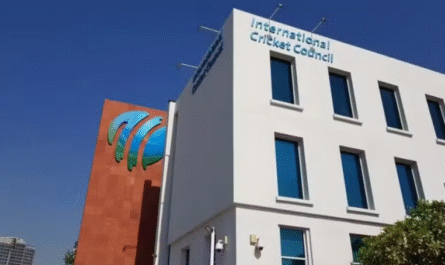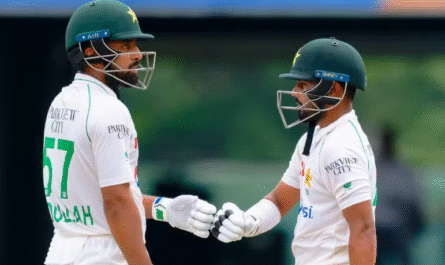In the ever-churning cauldron of Pakistani cricket, few stories captivate fans quite like that of Mohammad Hasnain. A bowler blessed with raw pace and a flair for the dramatic, Hasnain burst onto the international scene like a storm, only to find himself navigating a maze of challenges that have threatened to derail what once seemed like a meteoric rise. Today, the 24-year-old remains a fascinating case study of potential, pressure, and perseverance in the modern game.
The Meteoric Rise
Mohammad Hasnain’s entry into professional cricket was nothing short of explosive. Born in Hyderabad, Sindh, in 2000, he made headlines when he consistently clocked over 145 km/h during the 2019 Pakistan Super League (PSL), representing Quetta Gladiators. His raw pace and fearless approach earned immediate comparisons with Pakistan’s rich lineage of fast bowling icons—Wasim, Waqar, Shoaib Akhtar, and Mohammad Amir.
Selectors couldn’t ignore his thunderbolts. Hasnain was fast-tracked into the national team, making his ODI debut against Australia in March 2019, and later that year, his T20I debut. He was even selected for the 2019 World Cup squad—an astonishing leap for a teenager with little domestic experience.
During the early part of his career, Hasnain’s statistics weren’t eye-popping, but his pace and potential had scouts and fans salivating. He became one of the youngest bowlers to claim a T20I hat-trick, doing so against Sri Lanka in 2019 at just 19 years of age.
A Speedster’s Struggles
But the very thing that made Hasnain exceptional—his speed—also proved to be his greatest challenge. Like many young pacers, the emphasis on speed sometimes came at the cost of control, consistency, and fitness. Over the next two years, Hasnain oscillated in and out of the national side, never quite managing to cement his place.
Things took a darker turn in early 2022 when he was reported for a suspect bowling action during his stint in the Big Bash League (BBL) with the Sydney Thunder. An independent assessment confirmed the violation: some of his deliveries were exceeding the 15-degree elbow extension limit set by the ICC. The result? A suspension from international cricket until he could correct his action.
For a young cricketer already under pressure to perform, this was a hammer blow. Hasnain went off the radar for several months, undergoing biomechanical assessments and remodelling his action at the National High-Performance Centre (NHPC) in Lahore. Many feared this would be the end of his career—or at least, his raw pace.
The Redemption Arc
To Hasnain’s credit, he took the suspension as a challenge. With support from Pakistan Cricket Board (PCB) specialists and coaching staff, he returned in mid-2022 with a corrected action and renewed hunger. Though his remodelled action looked more refined, skeptics doubted whether he would ever regain his express pace.
Yet, during the Asia Cup 2022, Hasnain made a surprise comeback in place of an injured Shaheen Afridi. He didn’t set the tournament alight but showed promise with improved control and flashes of his old venom. There were signs that the Hyderabad-born tearaway might just write his comeback story after all.
Caught in the Middle
Since then, however, Hasnain’s international appearances have been sporadic. With fierce competition from Shaheen Shah Afridi, Naseem Shah, Haris Rauf, and newcomer Ihsanullah, Hasnain has found himself in a crowded fast bowling roster. Injuries and tactical changes haven’t helped his cause either.
Franchise cricket has kept his name afloat. He remains a popular pick in the PSL, where he still cranks it up into the 140s and serves as a reliable middle-overs enforcer. His performances for Quetta Gladiators continue to attract attention, though he hasn’t yet become the world-beating match-winner that some hoped for when he first emerged.
The larger question now is: where does Mohammad Hasnain go from here? Is he a future spearhead of Pakistan’s bowling attack? Or will he become one of many “what could have been” stories in Pakistan cricket?
Talent vs. Trajectory
Hasnain’s case underscores a broader problem in Pakistani cricket: the tendency to rush young talent into the limelight before they’re fully ready. In Hasnain’s case, the rush to debut him may have robbed him of vital years of technical development. The burden of expectations, combined with the need to deliver instant results, created an environment that’s often unforgiving for a developing player.
And yet, the very resilience he has shown—bouncing back from a suspension, regaining his action, and still maintaining pace—shows that Hasnain is no ordinary cricketer. His journey reflects both the fragility and the fighting spirit that defines Pakistan cricket.
The Road Ahead
For Hasnain, the path forward will require a few key ingredients:
- Consistent Opportunities: Whether in domestic cricket, the PSL, or national duties, Hasnain needs consistent game time to further refine his skills.
- Injury Management: As a fast bowler, avoiding long-term injuries is crucial. He must work closely with trainers and physios to manage workload.
- Mentorship: Learning from veterans like Wahab Riaz and Shoaib Akhtar—who themselves endured career highs and lows—could be invaluable.
- Role Definition: The selectors and coaching staff must define his role—whether he’s a new-ball bowler, a middle-overs enforcer, or a death-over specialist. Clarity will help Hasnain focus and specialize.
Conclusion
The curious case of Mohammad Hasnain is still a work in progress. He has experienced the best and worst that cricket has to offer—fame, failure, suspension, redemption—all before turning 25. While many young fast bowlers have faded into obscurity after early promise, Hasnain still has time on his side.
What he does with the next few years could determine whether he joins the pantheon of great Pakistani pacers or becomes another name in the list of could-have-beens. For now, fans and critics alike continue to watch with curiosity, hope, and a little caution.
Because in Pakistan cricket, the line between a star and a story is often just one spell away.



